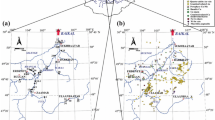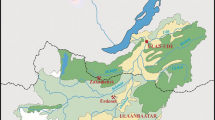Abstract
Mining activity in the North of Potosi (Siglo XX mine, Ingenio Catavi–Siglo XX, Pucro mine and Colquechaca mine) produces minewater containing high concentrations of heavy metals such as As (0.02–34 mg/l), Cd (45–11,600 μg/l), Cu (0.35–32 mg/l), Fe (42–1,010 mg/l), Pb(33–3,130 μg/l), Ni(20–4,320 μg/l), and Zn (1.1–485 mg/l), that exceed considerably the limit values. The rivers in the North of Potosi (Katiri and Pongoma) that do not receive minewater contain clear water with rather low heavy metal concentrations. These rivers and also other rivers contaminated with minewater, are tributaries of the Chayanta River that transports water with a high concentration of heavy metals such as As (6–24 μg/l), Cd (260–2,620 μg/l), Cu (205–812 μg/l), Pb(10–21 μg/l) and Ni(110–332 μg/l). These elements result from mining activity, as indicated by a comparison with rivers not contaminated by minewater discharges. Water of the Chayanta River, used all year long by the population of Quila Quila, (a village situated at about 75 km from the mining centers), for the irrigation of crops such as potato, maize and broad bean, contains heavy metal concentrations exceeding for several elements the guidelines for irrigation. As drinking water the population of Quila Quila consumes spring water with a generally acceptable heavy metal concentration, as well as infiltrated water of Chayanta River (which is also used in animal drinking troughs) with a high concentration of Cd (23–63 μg/l), exceeding the limit value for drinking water. The metal concentration is significantly lower in the infiltrated water than in the water of Chayanta River. Some technological solutions are suggested to improve the quality of the water used. Surveys carried out on inhabitants of the region, showed that many people present health problems, probably to be attributed to the bad quality of the water they consume and use for irrigation.
Similar content being viewed by others
References
Albert, L. (1985). Toxicología Ambiental. Mexico: Centro Panamericano de ecología Humana y Salud, OPS, OMS.
Brown, M., Barley, B., & Wood, H. (2002). Minewater treatment. Technology, Application and Policy. London: IWA.
Cámara Regional de Minería (1992). Informe técnico provincias Bustillo y Chayanta del Norte de Potosí (La Paz, Bolivia). Bolivia: Uncia.
De Ridder, A. (2006). Clay and zeolite characterisation for the treatment of pollution by heavy metals (Potosí, Bolivia), Dissertation, University of Leuven, Belgium.
Escobari, J. (2003). Problemática Ambiental en Bolivia. La Paz, Bolivia: Unidad de Análisis de Políticas Sociales y Económicas.
Fernández-Turiel, J. L., Llorens, J. F., Lopez-Vera, F., Gomez-Artola, C., Morell, I., & Gimeno, D. (2000). Strategy for water analysis using ICP-MS. Fresenius’ Journal of Analytical Chemistry, 368, 601–606.
Peñaloza, M., & Reinhardt, I. (2000). Problemas ambientales de la minería boliviana. La Paz, Bolivia: Fundación Manejo Integrado del Medio ambiente en la Pequeña Minería.
Pepelnik, R., Prange, A., Jantzen, E., Krause, P., & v.Tümpling, W. (1997). Development and application of ICP-MS in Elbe river research. Fresenius’ Journal of Analytical Chemistry, 359, 346–351.
Romero, M., & San Martin, J. (2003). Aguas de abastecimiento urbano y salud. Madrid, Spain: Universidad Complutense.
Rojas, J., & Vandecasteele, C. (2006) Removal of Cd from river water from Chayanta river, Bolivia (in preparation).
Sengupta, M. (1993). Environmental Impact of mining. Boca Raton, USA: Lewis.
Sparks, D. (2003). Environmental Soil Chemistry. New York, USA: Academic.
Author information
Authors and Affiliations
Corresponding author
Rights and permissions
About this article
Cite this article
Rojas, J.C., Vandecasteele, C. Influence of Mining Activities in the North of Potosi, Bolivia on the Water Quality of the Chayanta River, and its Consequences. Environ Monit Assess 132, 321–330 (2007). https://doi.org/10.1007/s10661-006-9536-7
Received:
Accepted:
Published:
Issue Date:
DOI: https://doi.org/10.1007/s10661-006-9536-7




